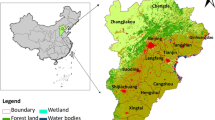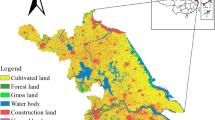Abstract
Context
Ecological security pattern (ESP) can maintain regional ecological security and thus support sustainable development. ESP should not only protect regional ecological processes, but also meet human demand for ecosystem services.
Objectives
It is aimed to propose a new method of identifying ecological sources in consideration of ecological background and demand, with a case study across the Guangdong-Hong Kong-Macao Greater Bay Area in view of interregional ecological conservation cooperation.
Methods
Ecological sources were identified with high supply and high comprehensively ecological supply–demand ratio (CESDR) of ecosystem services. Land use based resistance surface was modified using nighttime light intensity. Ecological corridors and potential ecological corridors were extracted using the Minimum Cumulative Resistance model.
Results
Ecological sources were mainly distributed in the north, accounting for 13.46% of the total area. Macao and Dongguan had no ecological sources, due to the high level of land urbanization, and the mismatch between high supply and high CESDR patches, respectively. Ecological sources in Hong Kong were connected with that in Shenzhen, showing good background of natural ecosystem connectivity as the foundation for interregional ecological conservation cooperation. Ecological corridors were mainly distributed in the periphery of the study area, connecting most cities except for Macao. The overall ESP showed a spatially circular pattern around the Greater Bay Area.
Conclusions
The new method for ecological source identification could effectively enhance the sustainability of ecosystem conservation in view of integrating supply and demand of ecosystem services. It was necessary for all the three regions to strengthen ecological conservation cooperation.








Similar content being viewed by others
References
Bai Y, Zhuang C, Ouyang Z, Zheng H, Jiang B (2011) Spatial characteristics between biodiversity and ecosystem services in a human-dominated watershed. Ecol Complex 8:177–183
Bai Y, Wong CP, Jiang B, Hughes AC, Wang M, Wang Q (2018) Developing China’s Ecological Redline Policy using ecosystem services assessments for land use planning. Nat Commun 9:3034
Balvanera P, Pfisterer AB, Buchmann N, He J, Nakashizuka T, Raffaelli D, Schmid B (2006) Quantifying the evidence for biodiversity effects on ecosystem functioning and services. Ecol Lett 9:1146–1156
Baró F, Haase D, Gómez-Baggethun E, Frantzeskaki N (2015) Mismatches between ecosystem services supply and demand in urban areas: a quantitative assessment in five European cities. Ecol Indic 55:146–158
Chen J, Jiang B, Bai Y, Xu X, Alatalo JM (2019) Quantifying ecosystem services supply and demand shortfalls and mismatches for management optimisation. Sci Total Environ 650:1426–1439
Dong J, Peng J, Liu Y, Qiu S, Han Y (2020) Integrating spatial continuous wavelet transform and kernel density estimation to identify ecological corridors in megacities. Landsc Urban Plan 199:103815
Fu Y, Shi X, He J, Yuan Y, Qu L (2020) Identification and optimization strategy of county ecological security pattern: a case study in the Loess Plateau, China. Ecol Indic 112:106030
Gomez-Baggethun E, Barton DN (2013) Classifying and valuing ecosystem services for urban planning. Ecol Econ 86:235–245
Gurrutxaga M, Rubio L, Saura S (2011) Key connectors in protected forest area networks and the impact of highways: a transnational case study from the Cantabrian Range to the Western Alps (SW Europe). Landsc Urban Plan 101:310–320
Han B, Wang X, Lu F, Duan X, OuYang Z (2008) Soil carbon sequestration and its potential by cropland ecosystems in China. Acta Ecol Sin 28:612–619
Huang J, Hu Y, Zheng F (2020) Research on recognition and protection of ecological security patterns based on circuit theory: a case study of Jinan city. Environ Sci Pollut Res 27:12414–12427
Knaapen JP, Scheffer M, Harms B (1992) Estimating habitat isolation in landscape planning. Landsc Urban Plan 23:1–16
Larson KL, Nelson KC, Samples SR, Hall SJ, Bettez N, Cavender-Bares J, Groffman PM, Grove M, Heffernan JB, Hobbie SE, Learned J (2016) Ecosystem services in managing residential landscapes: priorities, value dimensions, and cross-regional patterns. Urban Ecosyst 19:95–113
Li Y, Sun X, Zhu X, Cao H (2010) An early warning method of landscape ecological security in rapid urbanizing coastal areas and its application in Xiamen, China. Ecol Model 221:2251–2260
Li Y, Li Y, Zhou Y, Shi Y, Zhu X (2012) Investigation of a coupling model of coordination between urbanization and the environment. J Environ Manag 98:127–133
Li J, Jiang H, Bai Y, Alatalo JM, Li X, Jiang H, Liu G, Xu J (2016) Indicators for spatial-temporal comparisons of ecosystem service status between regions: a case study of the Taihu River Basin, China. Ecol Indic 60:1008–1016
Li S, Xiao W, Zhao Y, Lv X (2020) Incorporating ecological risk index in the multi-process MCRE model to optimize the ecological security pattern in a semi-arid area with intensive coal mining: a case study in Northern China. J Clean Prod 247:119143
Liang J, He X, Zeng G, Zhong M, Gao X, Li X, Li X, Wu H, Feng C, Xing W, Fang Y, Mo D (2018) Integrating priority areas and ecological corridors into national network for conservation planning in China. Sci Total Environ 626:22–29
Liu D, Chang Q (2015) Ecological security research progress in China. Acta Ecol Sin 35:111–121
MA (2005) Millennium ecosystem assessment: living beyond our means-natural assets and human well-being. World Resources Institute, Washington
Meersmans J, Arrouays D, van Rompaey AJJ, Pagé C, de Baets S, Quine TA (2016) Future C loss in mid-latitude soils: climate change exceeds land use mitigation potential. Sci Rep 6:35798
Nahuelhual L, Carmona A, Lozada P, Jaramillo A, Aguayo M (2013) Mapping recreation and ecotourism as a cultural ecosystem service: an application at the local level in Southern Chile. Appl Geogr 40:71–82
Ouyang Z, Zheng H, Xiao Y, Polasky S, Liu J, Xu W, Wang Q, Zhang L, Xiao Y, Rao E, Jiang L (2016) Improvements in ecosystem services from investments in natural capital. Science 352:1455–1459
Peng J, Tian L, Liu Y, Zhao M, Hu Y, Wu J (2017) Ecosystem services response to urbanization in metropolitan areas: thresholds identification. Sci Total Environ 607:706–714
Peng J, Pan Y, Liu Y, Zhao H, Wang Y (2018a) Linking ecological degradation risk to identify ecological security patterns in a rapidly urbanizing landscape. Habitat Int 71:110–124
Peng J, Yang Y, Liu Y, Hu Y, Du Y, Meersmans J, Qiu S (2018b) Linking ecosystem services and circuit theory to identify ecological security patterns. Sci Total Environ 644:781–790
Peng J, Zhao S, Dong J, Liu Y, Meersmans J, Li H, Wu J (2019) Applying ant colony algorithm to identify ecological security patterns in megacities. Environ Modell Softw 117:214–222
Peng J, Hu Y, Dong J, Mao Q, Liu Y, Du Y, Wu J, Wang Y (2020) Linking spatial differentiation with sustainability management: academic contributions and research directions of physical geography in China. Prog Phys Geogr 44:14–30
Su S, Li D, Yu X, Zhang Z, Zhang Q, Xiao R, Zhi J, Wu J (2011) Assessing land ecological security in Shanghai (China) based on catastrophe theory. Stoch Environ Res Risk Assess 25:737–746
Su Y, Chen X, Liao J, Zhang H, Wang C, Ye Y, Wang Y (2016) Modeling the optimal ecological security pattern for guiding the urban constructed land expansions. Urban For Urban Green 19:35–46
Teng M, Wu C, Zhou Z, Lord E, Zheng Z (2011) Multipurpose greenway planning for changing cities: a framework integrating priorities and a least-cost path model. Landsc Urban Plan 103:1–14
Toms JD, Lesperance ML (2003) Piecewise regression: a tool for identifying ecological thresholds. Ecology 84:2034–2041
Vergnes A, Kerbiriou C, Clergeau P (2013) Ecological corridors also operate in an urban matrix: a test case with garden shrews. Urban Ecosyst 16:511–525
Wang D, Chen J, Zhang L, Sun Z, Wang X, Zhang X, Zhang W (2019) Establishing an ecological security pattern for urban agglomeration, taking ecosystem services and human interference factors into consideration. PeerJ 7:e7306
Wang Y, Wu T, Li H, Skitmore M, Su B (2020) A statistics-based method to quantify residential energy consumption and stock at the city level in China: the case of the Guangdong-Hong Kong-Macao Greater Bay Area cities. J Clean Prod 251:119637
Wu J (2013) Landscape sustainability science: ecosystem services and human well-being in changing landscapes. Landsc Ecol 28:999–1023
Xu X, Yang G, Tan Y, Zhuang Q, Li H, Wan R, Su W, Zhang J (2016) Ecological risk assessment of ecosystem services in the Taihu Lake Basin of China from 1985 to 2020. Sci Total Environ 554:7–16
Yahdjian L, Sala OE, Havstad KM (2015) Rangeland ecosystem services: shifting focus from supply to reconciling supply and demand. Front Ecol Environ 13:44–51
Yu K (1996) Security patterns and surface model in landscape ecological planning. Landsc Urban Plan 36:1–17
Zhang L, Peng J, Liu Y, Wu J (2017) Coupling ecosystem services supply and human ecological demand to identify landscape ecological security pattern: a case study in Beijing-Tianjin-Hebei region, China. Urban Ecosyst 20:701–714
Funding
This research was financially supported by the National Natural Science Foundation of China (41271195).
Author information
Authors and Affiliations
Corresponding author
Ethics declarations
Conflict of interest
The authors declare no conflict of interest.
Additional information
Publisher's Note
Springer Nature remains neutral with regard to jurisdictional claims in published maps and institutional affiliations.
Rights and permissions
About this article
Cite this article
Jiang, H., Peng, J., Dong, J. et al. Linking ecological background and demand to identify ecological security patterns across the Guangdong-Hong Kong-Macao Greater Bay Area in China. Landscape Ecol 36, 2135–2150 (2021). https://doi.org/10.1007/s10980-021-01234-6
Received:
Accepted:
Published:
Issue Date:
DOI: https://doi.org/10.1007/s10980-021-01234-6




